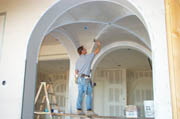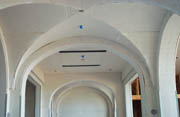
“On a scale of one to 10, it’s a ‘10’ just on size and volume,” says Mark Volk, owner of Volk Drywall. “If you take the volume out, it’s a ‘five’—a relatively easy house. As they get bigger, normally they do get harder but this one wasn’t too hard—just a lot of work!”
Volk is talking about his company’s labor on a recent custom-home project. The drywall contractor, of Covina, Calif., only works on high-end residences. The house required 150,000 sq. ft. of wallboard. The house has a floor footage of about 40,000 sq. ft. Not included in the footage is the 6,300 sq. ft. 18-car garage that took 13,000 sq. ft. of wallboard to complete. (Volk didn’t do the drywall in the garage). A playhouse on a hill required 6,000 sq. ft. of drywall. The guesthouses aren’t built yet. They are said to be about 6,000 sq. ft each and will take about 22,000 sq. ft of wallboard a piece to complete. There is a 14,000 sq. ft recreation room that will take about 42,000 sq. ft of wallboard. The property is located on 25 acres of land in Beverly Hills (90210) just off of Coldwater Canyon. The job was contracted in November, 2002, and as of this writing, the project is still underway. Volk’s crew included Shannon Volk, general supervisor, Tim Todd and Mike St.Pierre, taping foremen and Jose Reyes, hanging forman.
The general contractor was someone whom Volk worked for in the past, and that helped, he says. Volk credits his 23 years of experience as a taper for the ability to spot flaws before the GC.
“It helps the direction my company’s gone because most of the time, when custom homes require a higher amount of quality, I am able to see problems that others might not recognize,” he says.
“For example, if a painter was to roll a primer on the walls and rolled some edges across the wall, the contractor might look at that and say you have lines going up and down and might think it’s the drywaller,” Volk continues. “But I can tell if it’s the painter because of the pattern that a taper would use to finish the walls. In my experience, when painters spray on primer, it can leave bits of trash on walls. If we spray a Prepcoat, we sand it down. Painters, when they spray primer, they spray it and leave it. We ask our painters to roll on the primer. This way we know who’s responsible for what. Also, by rolling the primer instead of simply spraying, it helps impregnate the paper of the board with more material. Spraying the primer simply leaves a coat on top of the board and on top of the dust from sanding the mud. Rolling the primer is very important in my opinion. This is why all my contracts state that ‘the painter must roll primer before painting.’ This helps the end product a lot.”
As if the hanging the board wasn’t enough, the whole house has a 1/32- to 1/16-inch coat of mud on all drywall surfaces.
“On our proposal says ‘Level 5 Finish,’ which we applied to all the walls and ceilings,” Volk says. “We don’t want it too thick because of pock marks. We keep it thin and light enough not to have additional problems.”
This process involves thinning of the mud to the same consistency of taping mud, if slightly thicker. It is then rolled on and smoothed over with large blade right away. A worker with a blade follows the roller to give the immediate smoothing treatment. He wipes it down with the blade, leaving a thin layer of mud. The wall surfaces are then sanded and touched up. This is the skim coat.

Works well with others
Another memorable aspect of the job was hanging the foyer.“The entry has a 36-foot-high ceiling and we had to buy $2,000 worth of scaffolding to reach it,” Volk says. “That is an interesting area and could have been most difficult. We had to get it perfect because once the scaffolding comes down, you don’t want to have to put it back up to fix something.”
The size of the job inevitably meant many trades working together. However, Volk says his good relationship with the GC helped the job run smoothly and that it is scheduled for completion by July 2003. However, because of its size, repairs, obstacles and scheduling conflicts are common.
“This house has a lot of change orders,” Volk says. “They’ll tell us to start a playhouse even though the plumber still has work to do. Or we cannot do part of the entry because the electrician or alarm people have to run wire. So, it gets left and we have to go back and do it to match the area around it. It’s a problem when we have to go back and fix something time and time again, it throws the schedule off. If I have hangers there to complete the house and they can’t quite complete it, I have to send them to another project. When the area is freed to be finished, I have to bring the same guys back to complete the work.”
Each hallway with the barrel rolled ceilings took the hangers 95 hours of labor each. The metal took about 10 to hang and the tapers took about 55 hours to tape and skimcoat. Coordination of the trades, while challenging, was doable, Volk says. Other products Volk used included Hamilton Materials mud, Hamilton Materials TNT Lite for the skimcoat, National Gypsum drywall, USG drywall, Trim-Tex, Clinch-on cornerbead, Ames taping tools and Select’s Off-Angle Head to cove the off-angles.
“Mostly, we had the areas of the house to ourselves we were working on since it was being done in wings or phases at a time,” he says. “We started working downstairs in the right wing, where the maid’s quarters and butler’s pantry is. We actually managed to do the whole house with minimum people. It might normally take 18 hangers and 20 tapers to finish in the appropriate time, but we’ve been able to do most of the hanging with four or five people, or even less.”

Report Abusive Comment